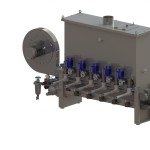Pet Coke Solid fuel
We have been witnessing for some years a revival in the use of solid fuels (coal, Pet coke, biomass) instead of liquid fuels (diesel and heavy oil) and gaseous fuels. This is due to the fact that the continuous rise of the prices of classical fuel used in heavy clay plants obliges the users to search the alternative sources glimpsing into the past. In a few words we have an increasing interest to use as a fuel the following ones: coal, biomass, Pet Coke. The latter in particular is always in a greater use, being a derivative of the production of liquid fuels, it has a very good LHV assessable around 7,500 Kcal / kg.
Pet Coke is the product obtained by the condensation process through the thermal cracking of heavy oil and oily residues. In the firing process a pushed thermal cracking happens that gives a rise, through the thermal cracking reactions, to liquid fractions and to coke which consist of up to 90-95% of carbon.
It is a residue with a spongy or compact consistency (petroleum coke, or pet coke). Coke thus consists of polycyclic aromatic hydrocarbons with high molecular weight and has a high carbon content and low ash content.
Typical composition of Pet Coke
- Carbon 84-97%
- Sulfur 0.2 to 6%
- Volatile substances 2.0 – 15%
- Hydrogen <5%
- Iron 50-2000 mg / kg
- Vanadium 5-2000 mg / kg
- Boro 0.1 – 0.5 mg / kg
- Nickel 0.1 to 3000 mg / kg
On 15th January 2004 the European Court of Justice excluded pet coke from the notion of the waste of refining by-product affirming that “coke produced voluntarily from petroleum or resulting from the simultaneous production of other oily combustible substances in an oil refinery and used with certainty as fuel for the energy needs of the refinery and other industries, does not constitute a waste within the meaning of Council Directive of 15th July 1975, 75/442/EEC on wastes, as amended by Council Directive 18th March 1991, 91/156/EEC. ”
And this is an important conclusion for Pet Coke to exist lawfully among fuels of common use.
Below you may find a table showing the variability range and average values of the main features of more than 300 samples of fossil coal and about 500 samples of pet coke. The comparison shows the extreme values and the average values of the most significant parameters of the fossil coal and pet coke.
| Fuel | Unit of measure | Fossil coal | Petcoke | ||||
| Components | MIN | MAX | MEDIO | MIN | MAXM | MEDIO | |
| Ashes | % m/m | 6,67 | 18,2 | 13,85 | 0,20 | 5,0 | 1,16 |
| Volatile substances | % m/m | 10,73 | 41,11 | 24,80 | 9,74 | 16,74 | 13,07 |
| Carbon | % m/m | 63,05 | 80,68 | 71,27 | 82,34 | 88,35 | 86,61 |
| Hydrogen | % m/m | 2,50 | 4,60 | 3,85 | 2,98 | 4,04 | 3,63 |
| Nitrogen | % m/m | 1,48 | 2,30 | 1,77 | 1,27 | 2,70 | 1,79 |
| Sulfur | % m/m | 0,21 | 1,21 | 0,48 | 2,76 | 6,63 | 4,89 |
| Chlorine | m/m< | – | – | – | 0,01 | 0,09 | 0,02 |
| Vanadium | mg/kg | – | – | – | 390 | 4660 | 1812 |
| H.C.V. | kcal/kg | 5796 | 7788 | 6729 | 7678 | 8569 | 8365 |
| H.C.V. | MJ/kg | 24,30 | 32,60 | 28,15 | 31,55 | 35,90 | 35,00 |
| L.H.V. | kcal/kg | 5618 | 7562 | 6527 | 7489 | 8378 | 8176 |
| L.H.V. | MJ/kg | 23,50 | 31,65 | 27,35 | 31,35 | 35,10 | 34,25 |
| Initial particle size | Mm | 0 | 20 | 20 | 0 | 20 | 20 |
| Final particle size | micron | 80 | 100 | 90 | 80 | 100 | 90 |
| Initial moisture | % | 6 | 6 | ||||
The cost saving on average figures of Pet Coke cost
The advantage of its use is evident if we compare its use with the one of the heavy oil, for a tunnel kiln for bricks firing, on a basis of average prices on the market until the year 2011 as indicated below:
- Pet coke 200 Euro / tons l.h.v. 7,500 Kcal/kg
- Heavy oil 520 Euro / tons l.h.v. 9,500 Kcal/kg
we get the following results relevant to a kiln of 400 tons/day, assuming a power demand of 320 Kcal / kg, you will have a daily demand of 128 million Kcal. Since 20% of energy must be supplied by gas or heavy oil burners, you can see on 80% of the remaining energy demand (ie on 102 400 000 Kcal / day), the advantage of using the Pet Coke instead of heavy oil:
- Pet Coke 102.4 million / 7,500 = 13.653 ton / day equal to 13.653 x 200 = 2,730 Euro / day
- Heavy oil 102 400 000 / 9.500 = 10.778 ton / day equal to 10.778 x 520 = 5,605 Euro / day
Therefore, there would be a saving of 2,875 Euro / day so 86,250 Euro / month.
Since the installation of a complete system of Pet Coke micronization, its silage of the transport augers, of the burners set on the kiln costs about 400,000 euros, the investment would be paid back in less than five months.
One may add to the above how an existing combustion installation for solid fuels has reached very high levels of efficiency summarized as follows:
- Autonomous control of each burner composed of 9-16 combustion pipes
- Autonomous control of the relationship Coke / combustion air on each combustion pipe
We can say about the use of Pet Coke to be an alternative and a very good solution similar to the gas use, better than Heavy Oil use as regards the combustion efficiency.
Biomass
In the energetic field, the term “biomass” refers to various products mainly of vegetable origin, and only to a lesser extent they are of animal origin, used to produce energy: agricultural and forestry residues, waste wood industry, such as wood chips and sawdust, “energy crops” (or plants specifically grown for energy purposes), waste from livestock farms and agro-industrial residues (residues of crops intended for human consumption or animal food such as straw).
Biomass is one of the most renewable resources available on our planet. In 2009 biomass covered about 10% of energy use in the world (International Energy Agency, Key World Energy Statistics 2011). Their use, however, is not spread in a homogenous way. In fact, in the countries in the developing world, this source of energy covers from 34% to 40% of the total energy requirement. On the contrary, in the industrialized countries its contribution is much more modest, hardly 3% of the biomass for the primary energy use. In particular, the United States get 3.2% from their biomass energy, Europe in total 3.5%.
Exceptionally, in Sweden and Finland, by burning the wastes of the forestry industry, a quantity of electric energy is produced enough to cover respectively 17% and 15% of the national demand for electric energy. In Austria biomass covers 13% of the national electricity demand. In Italy, however, the contribution of biomass to the national energy balance is limited to 2-3%. This distribution does not take into account only the attention and economic commitment of some countries for the research and development of new technologies, but also the actual availability of land where the “energy crops” can be localized. It is estimated, in fact, that in the developed countries the replacement of fossil fuels with biomass would require the availability of over 950 mega-ha (million hectares) of land to be allocated to energy crops. Forefront in the use of biomass as an energy source are the countries of the North – Central Europe, which have installed large cogeneration installations (combined heat and power production), and biomass-fueled district heating. France, which has the largest agricultural area in Europe, focuses a lot on the production of biodiesel and ethanol to use them as fuels and it has adopted a policy of complete tax exemption in this regard. Great Britain on the other hand, developed a production of bio-fuels, which are currently considered uneconomical, and it was dedicated in particular to the development of a comprehensive and efficient system for the recovery of biogas from landfills, both for heating and electric purposes. Sweden and Austria, which have a long tradition to use firewood, continued to increase this use for heating and for district heating, giving great incentive to plantation of coppice (willow, poplar), whose yields are 3 -4 times higher than the average raw material supply. Italy with its 7,631 GWh is at the 5th place among the EU15 countries for the production deriving from solid biomass, waste, biogas and bio liquids. Germany is the country where in 2009 the production was the highest one and amounted to 33,796 GWh. The others follow at a distance, in Sweden the production amounted to 11,122 GWh, in Britain to 10,571.








